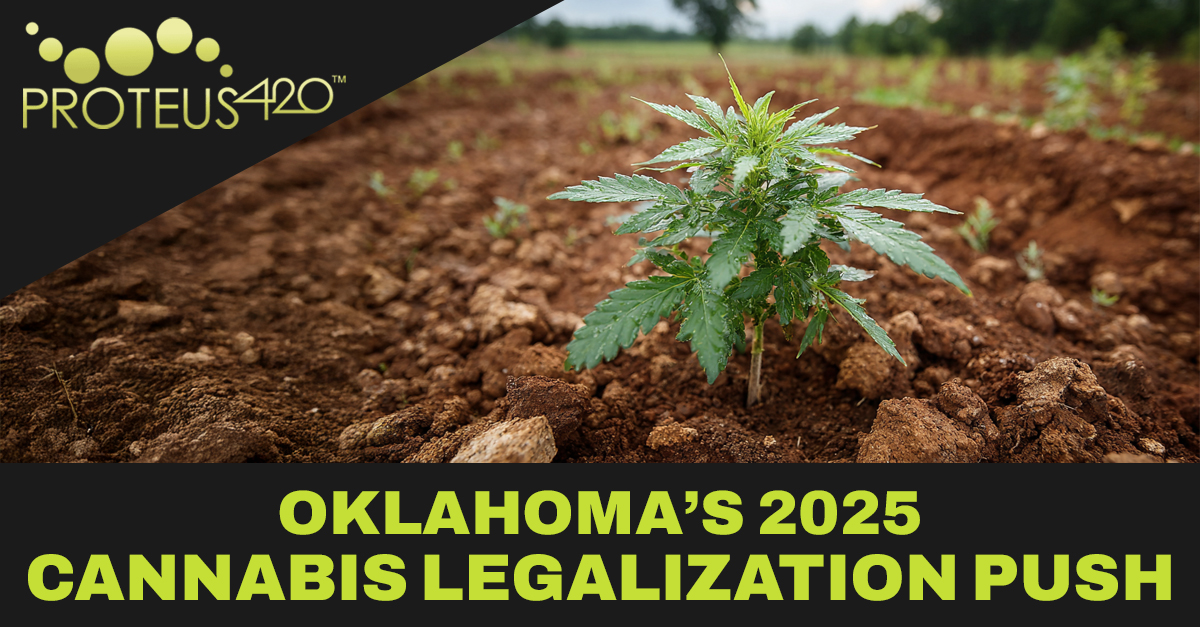Oklahoma’s 2025 Cannabis Legalization Push: What’s Different This Time?

Oklahoma’s 2025 Cannabis Legalization Push: What’s Different This Time?
Oklahoma’s latest effort to legalize recreational cannabis is entering its final stretch, and it is not the same fight advocates faced two years ago. The campaign, now circulating petitions for the 2025 ballot (State Question 837), faces a brand-new legal landscape shaped by tougher initiative laws, higher signature hurdles, and a renewed push from advocates determined to give Oklahomans another chance at adult-use legalization.
Here is how 2025’s initiative differs from 2023’s, and why this new push matters more than ever.
What Happened in 2023: State Question 820
In March 2023, Oklahoma voters rejected State Question 820, which would have legalized recreational cannabis for adults 21 and older. The measure would have:
- Allowed possession of up to 1 ounce of flower and 8 grams of concentrate
- Permitted home cultivation of six mature plants and six seedlings
- Imposed a 15% excise tax on recreational sales
- Placed oversight under the Oklahoma Medical Marijuana Authority (OMMA)
- Granted automatic expungement for some past cannabis-related convictions
While SQ 820 was backed by strong public support early on, it ultimately failed with nearly 62% of voters saying “No.” Timing, low turnout (due to a special March election), and opposition campaigns from state officials played major roles in its defeat.
What’s on the Table in 2025: State Question 837
Two years later, advocates are back with a stronger and more constitutionally grounded proposal: State Question 837. This initiative would:
- Legalize adult-use cannabis for ages 21 and up
- Expand possession limits to as much as 8 ounces
- Allow for 12 home-grown plants
- Reduce the excise tax to 10%
- Remove the medical marijuana excise tax entirely
- Keep regulation within the OMMA
- Enshrine these rights as a constitutional amendment, not just a statutory law
Because this measure would amend the state constitution, it is much harder for future legislators to roll back or rewrite.

The Biggest Difference: A Tougher Path to the Ballot
In 2025, cannabis reform advocates are not just fighting for legalization, they are also fighting against new procedural barriers. That is because of Senate Bill 1027, a new law passed this year that dramatically changes how Oklahoma’s initiative process works.
| Key Factor | 2023 Initiative (SQ 820) | 2025 Initiative (SQ 837) |
|---|---|---|
| Type of Measure | Statutory (easier to qualify) | Constitutional (harder to qualify but harder to repeal) |
| Signature Requirements | Based on total state votes for governor | Same base, but must meet county-level distribution caps |
| County Caps | No limit per county | No more than 20.8% of signatures can come from any one county |
| Circulator Rules | Flexible (no pay or residency limits) | No pay-per-signature; must be Oklahoma residents |
| Tax Rate | 15% excise tax | 10% excise tax; removes medical tax |
| Home Grow | 6 plants | 12 plants |
| Possession Limit | 1 ounce | 8 ounces |
| Regulatory Body | OMMA | OMMA (unchanged) |
| Time to Gather Signatures | 90 days | 90 days (same), but under far tougher conditions |
These rules mean that petition teams must gather more signatures across more counties, under stricter compliance rules, and within the same short 90-day window.
Why Advocates Are Still Pushing Forward
Despite the tougher path, advocates argue that Oklahoma’s massive medical cannabis market — now over 350,000 active patients — shows strong public support for reform. Many voters see the 2023 defeat not as a rejection of legalization itself, but of how and when the vote was held. A general election year could bring far higher turnout and a more favorable electorate.
Additionally, a constitutional amendment provides a stronger safeguard against future legislative rollbacks, a key lesson from other states where lawmakers have altered or weakened voter-approved cannabis measures.
What’s Next
If SQ 837’s backers succeed in gathering enough valid signatures, the measure could appear on the November 2025 ballot (or early 2026, depending on timing). That would give Oklahoma voters a second chance to shape the state’s cannabis future, this time with more durable protections and a broader scope of legalization.
In Short
- SQ 820 (2023): Tried to legalize via statutory law — failed amid low turnout.
- SQ 837 (2025): Aims to legalize via the state constitution, expanding possession, lowering taxes, and enduring political changes — but faces a much tougher qualification process.
Stay Informed
Follow PROTEUS420 News for industry analysis, regulatory updates, and insight into how state initiatives affect compliance and cannabis business operations nationwide.


